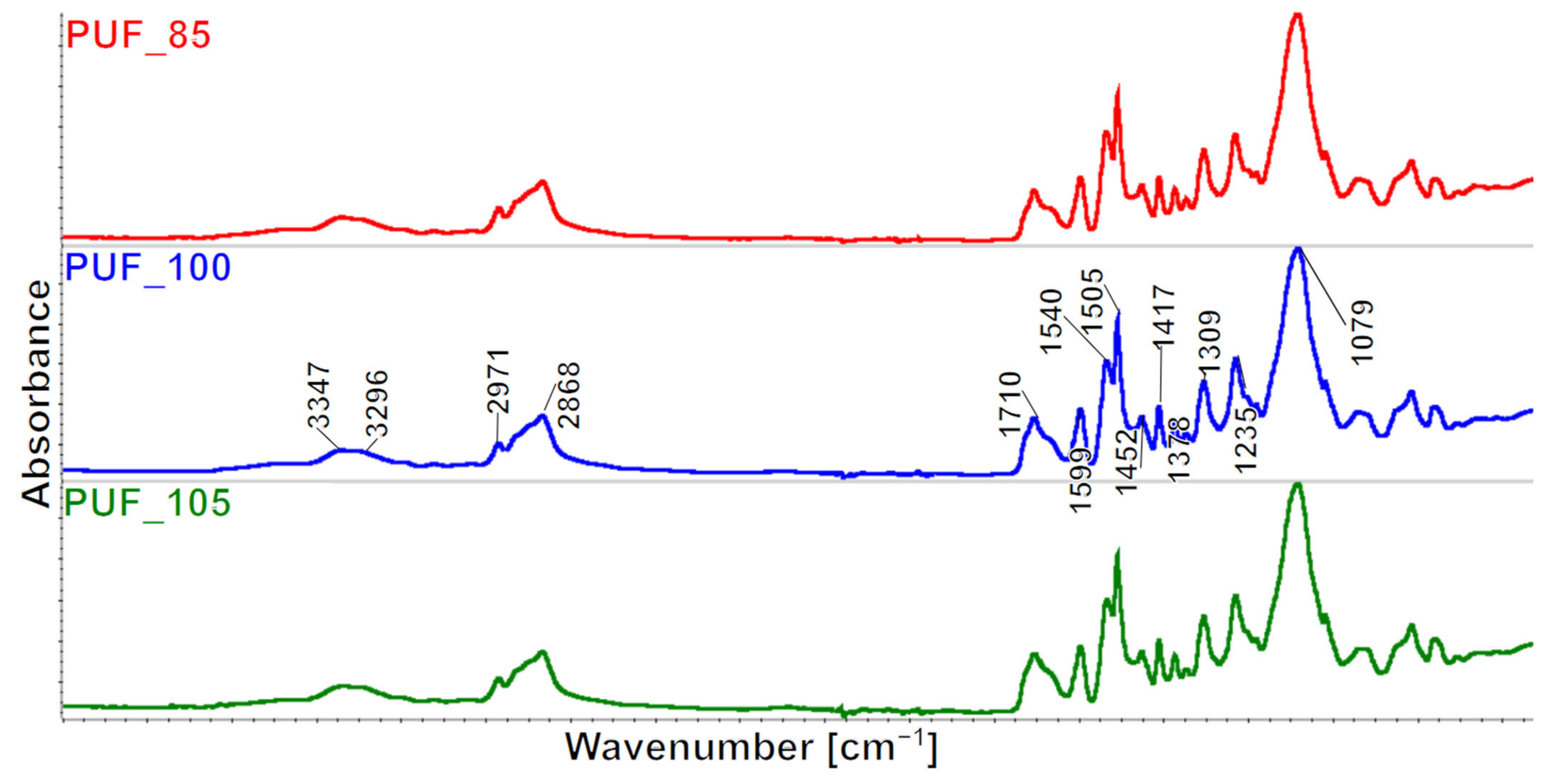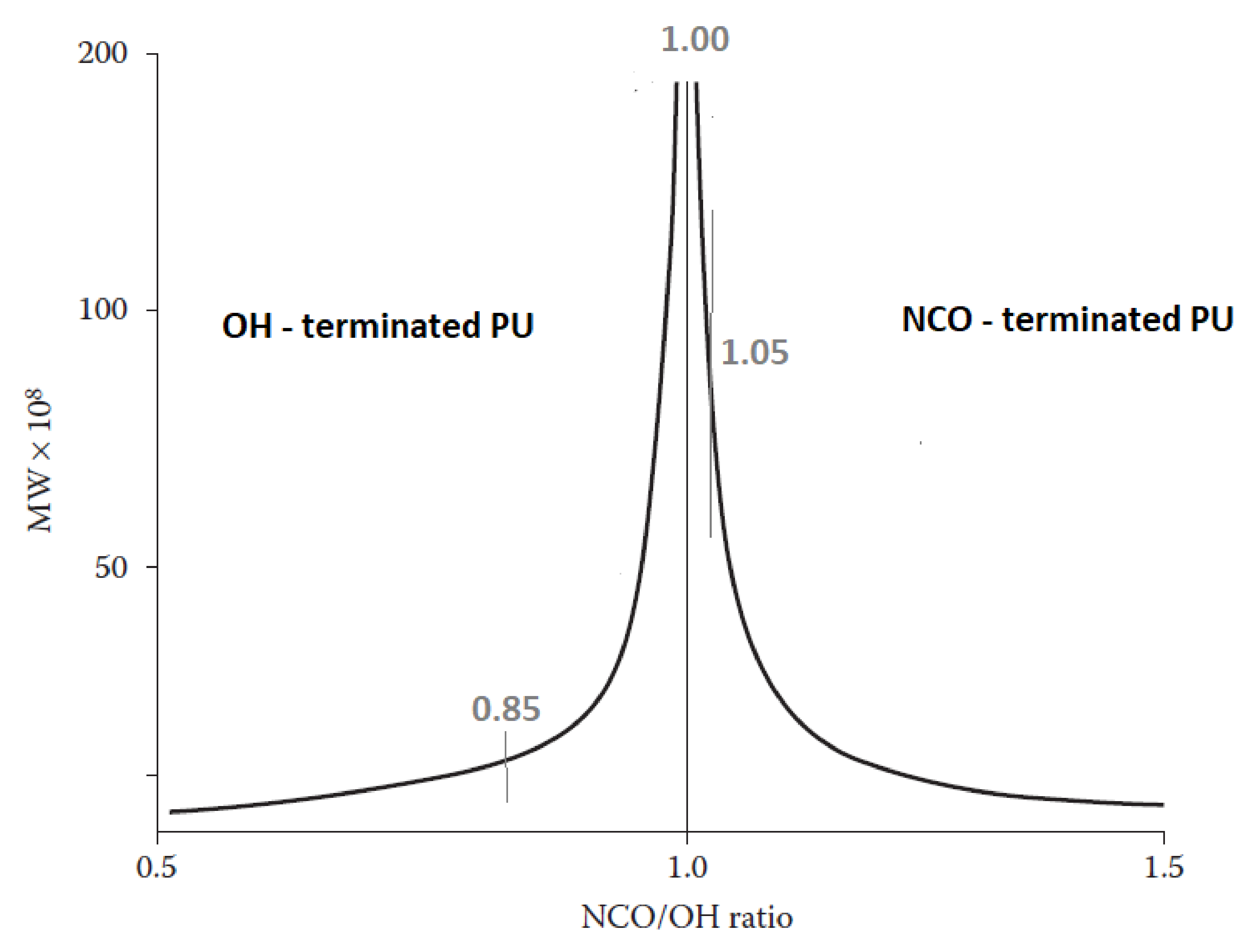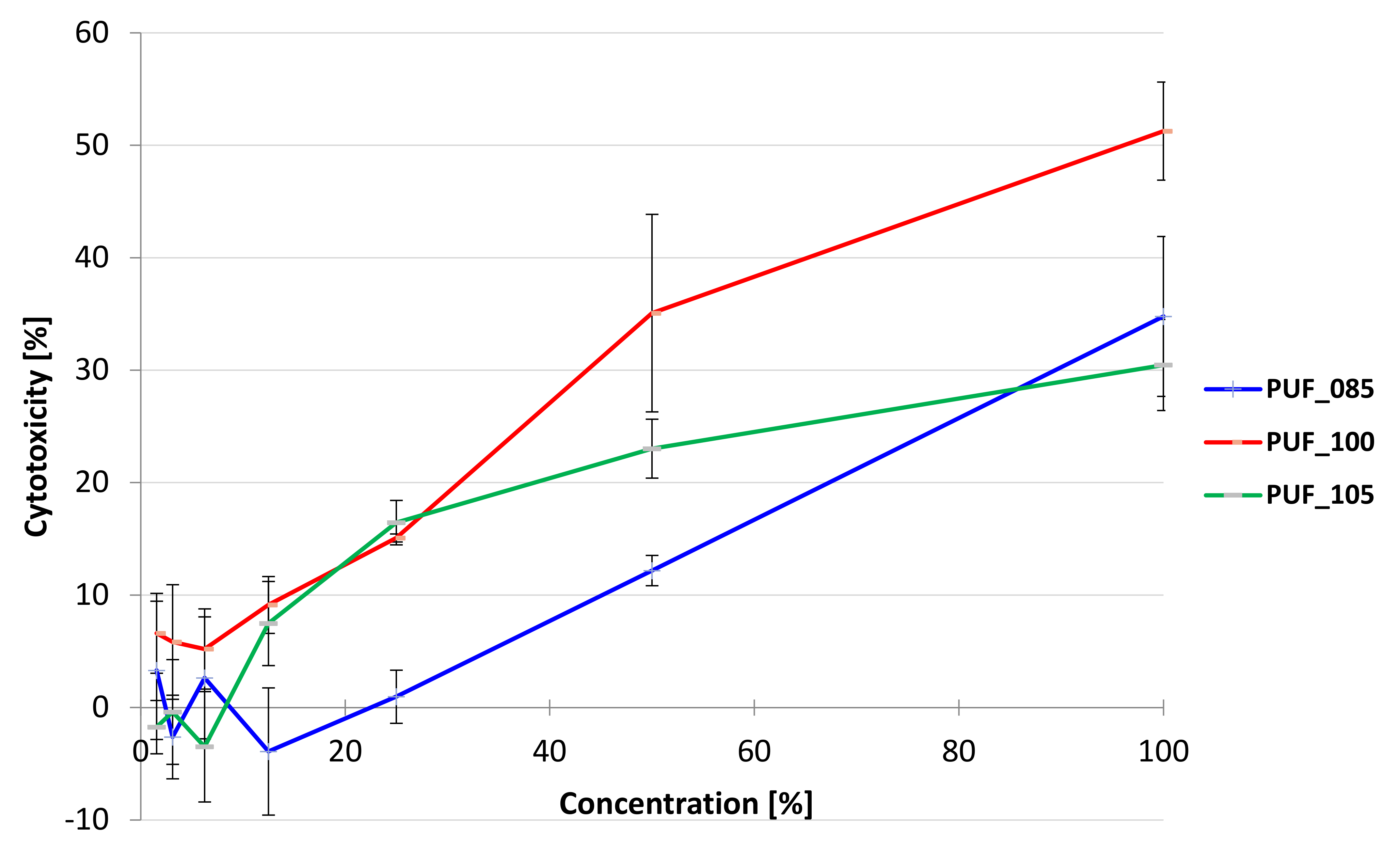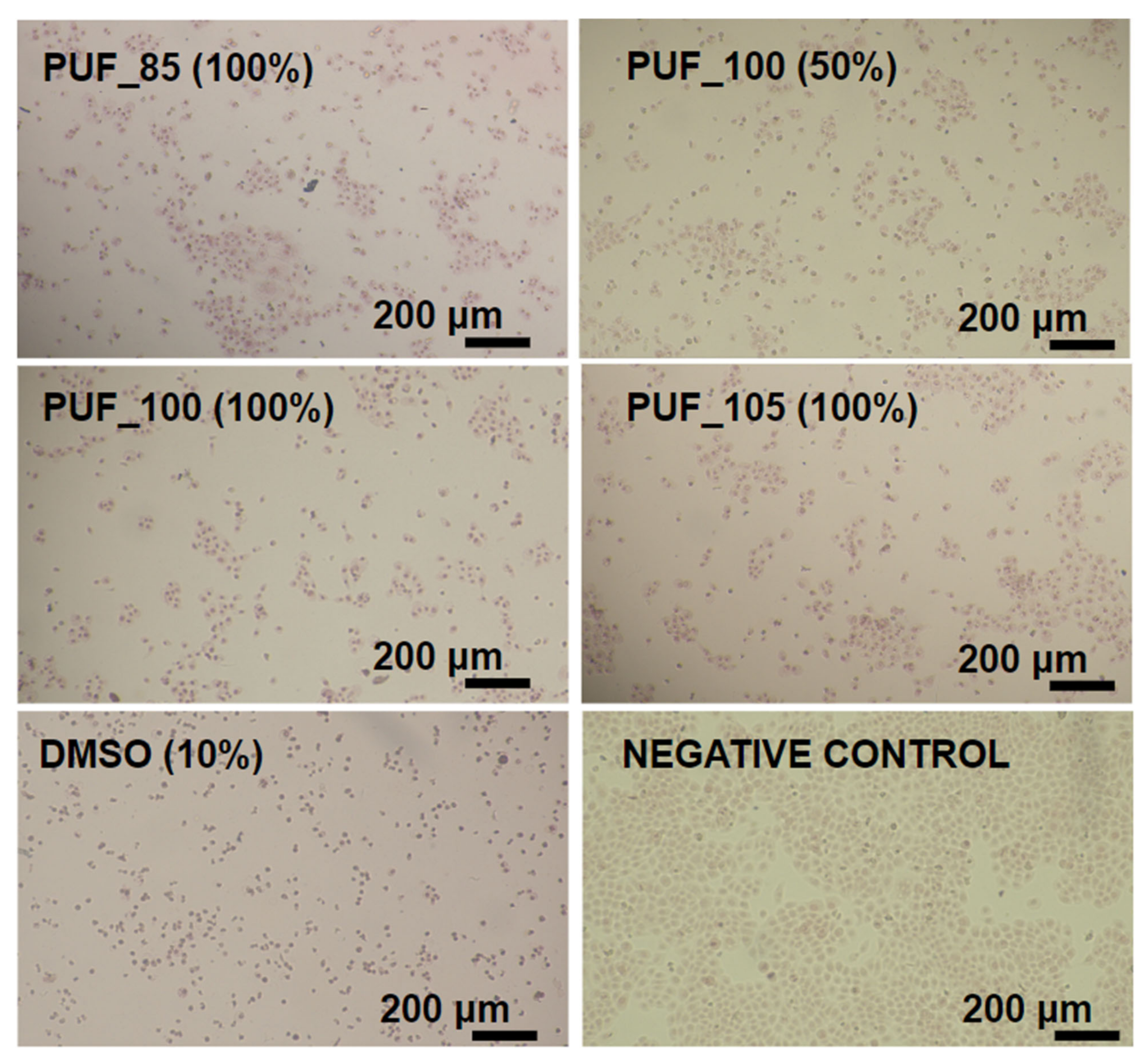Cytotoxic Properties of Polyurethane Foams for Biomedical Applications as a Function of Isocyanate Index
Abstract
1. Introduction



2. Materials and Methods
2.1. Materials
- Polyols: Voranol CP 1421, polyether triol with a high content of ethylene oxide (33 mg KOH/g, Average Molecular Weight: 5023 g/mol, Dow, MI, USA), Rokopol D2002—a polyoxypropylenediol (53–59 mg KOH/g, Average Molecular Weight: 2000 g/mol, PCC Rokita, Brzeg Dolny, Poland) and Rokopol G500—a polyoxyalkylenetriol (290–310 mg KOH/g Average Molecular Weight ~560 g/mol, PCC Rokita, Brzeg Dolny, Poland);
- Catalysts: Dabco NE 1070-N, N-dimethyl aminopropyl urea, (H2NCO)NH(CH2)3N(CH3)2, molecular weight 145 g/mol (Air Products, Allentown, Pennsylvania, USA); trifunctional, amine, reactive catalyst, and Jeffcat DPA (Huntsman, The Woodlands, TX, USA)-N-(3-dimethylamino-propyl)-N,N-diisopropanolamine, amine(III-terminal amine), reactive-, two hydroxyl groups catalyst;
- Surfactants: silicone surfactants Tegostab B404 and Tegostab B4900 (Evonik Industries, Essen, Germany);
- Isocyanate: Ongronat TR 4040 isocyanate—a mixture of MDI mixed isomers and oligomeric MDI (31.6–33.6% NCO/wt.%, BorsodChem, Kazincbarcika, Hungary).
2.2. Methods
2.2.1. Synthesis Parameters and Apparent Density
2.2.2. Fourier Transform Infrared Spectroscopy (FTIR)
2.2.3. Foam Extracts Preparation
2.2.4. HaCaT Cell Culture
2.2.5. Neutral Red Uptake (NRU) Assay
3. Results
3.1. Synthesis Parameters and Apparent Density
3.2. Fourier Transform Infrared Spectroscopy (FTIR)
Cytotoxic Activity of Polyurethane Foam Extracts
4. Conclusions
Supplementary Materials
Author Contributions
Funding
Institutional Review Board Statement
Informed Consent Statement
Data Availability Statement
Conflicts of Interest
References
- Gunatillake, P.A.; Meijs, G.F.; McCarthy, S.J. Developments in design and synthesis of biostable polyurethanes. In Biomedical Applications of Polyurethanes; Vermette, P., Ed.; Landes Bioscience: Georgetown, TX, USA, 2001; pp. 160–170. [Google Scholar]
- Lamba, N.M.K.; Woodhouse, K.A.; Cooper, S.L. Polyurethanes in Biomedical Applications, 1st ed.; CRC Press: New York, NY, USA, 2017. [Google Scholar] [CrossRef]
- Pinchuk, L. A review of the biostability and carcinogenicity of polyurethanes in medicine and the new generation of ‘biostable’ polyurethanes. J. Biomater. Sci. 1995, 6, 225–267. [Google Scholar] [CrossRef] [PubMed]
- Mandarino, M.P.; Salvatore, J.E. Polyurethane polymer—Its use in fractured and diseased bones. Am. J. Surg. 1959, 97, 442–446. [Google Scholar] [CrossRef] [PubMed]
- Boretos, J.W.; Pierce, W.S. Segmented Polyurethane: A New Elastomer for Biomedical Applications. Science 1967, 158, 1482–1484. [Google Scholar] [CrossRef]
- Akutsu, T.; Houston, C.S.; Kolff, W.J. Roller type of artificial heart within the chest: Preliminary report. Am. Heart J. 1960, 59, 731–736. [Google Scholar] [CrossRef] [PubMed]
- Cavaco, L.I.; Melo, J.A. Polyurethane: Properties, Structure and Applications; Cavaco, L.I., Melo, J.A., Eds.; Nova Science Publishers: New York, NY, USA, 2012. [Google Scholar]
- Venkateshaiah, A.; Padil, V.V.T.; Nagalakshmaiah, M.; Waclawek, S.; Černík, M.; Varma, R.S. Microscopic Techniques for the Analysis of Micro and Nanostructures of Biopolymers and Their Derivatives. Polymers 2020, 12, 512. [Google Scholar] [CrossRef] [PubMed]
- Rusu, L.C.; Ardelean, L.C.; Jitariu, A.A.; Miu, C.A.; Streian, C.G. An insight into the structural diversity and clinical applicability of polyurethanes in biomedicine. Polymers 2020, 12, 1197. [Google Scholar] [CrossRef]
- Wendels, S.; Avérous, L. Biobased polyurethanes for biomedical applications. Bioact. Mater. 2021, 6, 1083–1106. [Google Scholar] [CrossRef]
- Akindoyo, J.O.; Beg, M.D.H.; Ghazali, S.; Islam, M.R.; Jeyaratnam, N.; Yuvaraj, A.R. Polyurethane types, synthesis and applications—A review. RSC Adv. 2016, 6, 114453–114482. [Google Scholar] [CrossRef]
- Tian, H.; Yao, Y.; Ma, S.; Wu, J.; Xiang, A. Enhanced thermal stability and flame resistance of polyurethane-imide foams by adding silicon carbide. Adv. Polym. Technol. 2018, 37, 2470–2477. [Google Scholar] [CrossRef]
- Tian, H.; Yao, Y.; Zhang, S.; Wang, Y.; Xiang, A. Enhanced thermal stability and flame resistance of rigid polyurethane-imide foams by varying copolymer composition. Polym. Test. 2018, 67, 68–74. [Google Scholar] [CrossRef]
- Bernardini, J.; Cinelli, P.; Anguillesi, I.; Coltelli, M.B.; Lazzeri, A. Flexible polyurethane foams green production employing lignin or oxypropylated lignin. Eur. Polym. J. 2015, 64, 147–156. [Google Scholar] [CrossRef]
- Cinelli, P.; Anguillesi, I.; Lazzeri, A. Green synthesis of flexible polyurethane foams from liquefied lignin. Eur. Polym. J. 2013, 49, 1174–1184. [Google Scholar] [CrossRef]
- Adrover-Rigo, M.; Cardona Roselló, J.; Fernández Méndez, J.M.; Fullana Matas, A.; Galmés Hernández, S.; García Raya, M.D.; Hernández Yeste, M.S.; Marín Fernández, M.R.; Pérez Álvarez, A.; Rodríguez Cancio, C.; et al. Prevenció i Tractament de les Úlceres per Pressió. 2018. Available online: http://hdl.handle.net/20.500.13003/18225 (accessed on 19 March 2023).
- Orlando, P.L. Pressure ulcer management in the geriatric patient. Ann. Pharmacother. 1998, 32, 1221–1227. [Google Scholar] [CrossRef]
- Gorecki, C.; Brown, J.M.; Nelson, E.A.; Briggs, M.; Schoonhoven, L.; Dealey, C.; Defloor, T.; Nixon, J.; on behalf of the European Quality of Life Pressure Ulcer Project Group. Impact of pressure ulcers on quality of life in older patients: A systematic review: Clinical investigations. J. Am. Geriatr. Soc. 2009, 57, 1175–1183. [Google Scholar] [CrossRef] [PubMed]
- Korley, L.S.T.J.; Pate, B.D.; Thomas, E.L.; Hammond, P.T. Effect of the degree of soft and hard segment ordering on the morphology and mechanical behavior of semicrystalline segmented polyurethanes. Polymer 2006, 47, 3073–3082. [Google Scholar] [CrossRef]
- Ioan, S.; Grigorescu, G.; Stanciu, A. Effect of segmented poly(ester-siloxane)urethanes compositional parameters on differential scanning calorimetry and dynamic-mechanical measurements. Eur. Polym. J. 2002, 38, 2295–2303. [Google Scholar] [CrossRef]
- Sánchez-Adsuar, M.S. Influence of the composition on the crystallinity and adhesion properties of thermoplastic polyurethane elastomers. Int. J. Adhes. Adhes. 2000, 20, 291–298. [Google Scholar] [CrossRef]
- Xu, Y.; Petrovic, Z.; Das, S.; Wilkes, G.L. Morphology and properties of thermoplastic polyurethanes with dangling chains in ricinoleate-based soft segments. Polymer 2008, 49, 4248–4258. [Google Scholar] [CrossRef]
- Okrasa, M.; Leszczyńska, M.; Sałasińska, K.; Szczepkowski, L.; Kozikowski, P.; Nowak, A.; Szulc, J.; Adamus-Włodarczyk, A.; Gloc, M.; Majchrzycka, K.; et al. Viscoelastic polyurethane foams with reduced flammability and cytotoxicity. Materials 2022, 15, 151. [Google Scholar] [CrossRef]
- Huynh, P.T.; Nguyen, G.D.; Le Tran, K.T.; Ho, T.M.; Lam, V.Q.; Bown, M.; Ngo, T.V.K. Study on green preparation of multi-branched gold nanoparticles loaded flexible polyurethane foam for antibacterial dressing. Nanocomposites 2022, 8, 167–174. [Google Scholar] [CrossRef]
- Gu, X.; Xu, Z.; Gu, L.; Xu, H.; Han, F.; Chen, B.; Pan, X. Preparation and antibacterial properties of gold nanoparticles: A review. Environ. Chem. Lett. 2021, 19, 167–187. [Google Scholar] [CrossRef]
- Anees Ahmad, S.; Das, S.S.; Khatoon, A.; Ansari, M.T.; Afzal, M.; Hasnain, S.; Nayak, A.K. Bactericidal activity of silver nanoparticles: A mechanistic review. Mater. Sci. Energy Technol. 2020, 3, 756–769. [Google Scholar] [CrossRef]
- Voronkov, M.G.; Lavrent’yev, V.I. Polyhedral Oligosilsesquioxanes and Their Homo Derivatives. In Inorganic Ring Systems; Springer: Berlin/Heidelberg, Germany, 1982; pp. 199–238. [Google Scholar] [CrossRef]
- Grzęda, D.; Węgrzyk, G.; Nowak, A.; Komorowska, G.; Szczepkowski, L.; Ryszkowska, J. Effect of Different Amine Catalysts on the Thermomechanical and Cytotoxic Properties of ‘Visco’-Type Polyurethane Foam for Biomedical Applications. Materials 2023, 16, 1527. [Google Scholar] [CrossRef]
- ISO: 845-06; Cellular Plastics and Rubbers—Determination of Apparent Density. International Organization for Standardization: Geneva, Switzerland, 2006.
- ISO 10993-12:2012(E); Biological Evaluation of Medical Devices—Part 12: Sample Preparation and Reference Materials. International Organization for Standardization: Geneva, Switzerland, 2012.
- Boukamp, P. Normal Keratinization in a Spontaneously Immortalized. J. Cell Biol. 1988, 106, 761–771. [Google Scholar] [CrossRef] [PubMed]
- ISO 10993-5:2009; Biological Evaluation of Medical Devices—Part 5: Tests for In Vitro Cytotoxicity. International Organization for Standardization: Geneva, Switzerland, 2009.
- Szycher, M. Szycher’s Handbook of Polyurethanes, 2nd ed.; CRC Press: Boca Raton, FL, USA, 2012; Volume 142, no. 3602. [Google Scholar]
- Reignier, J.; Méchin, F.; Sarbu, A. Chemical gradients in PIR foams as probed by ATR-FTIR analysis and consequences on fire resistance. Polym. Test. 2021, 93, 106972. [Google Scholar] [CrossRef]
- Petrović, Z.S.; Ferguson, J. Polyurethane elastomers. Prog. Polym. Sci. 1992, 16, 695–836. [Google Scholar] [CrossRef]
- Heintz, A.M.; Duffy, D.J.; Nelson, C.M.; Hua, Y.; Hsu, S.L.; Suen, W.; Paul, C.W. A spectroscopic analysis of the phase evolution in polyurethane foams. Macromolecules 2005, 38, 9192–9199. [Google Scholar] [CrossRef]
- Kim, J.M.; Kim, D.H.; Kim, J.; Lee, J.W.; Kim, W.N. Effect of graphene on the sound damping properties of flexible polyurethane foams. Macromol. Res. 2017, 25, 190–196. [Google Scholar] [CrossRef]
- Baghban, S.A.; Khorasani, M.; Sadeghi, G.M.M. Acoustic damping flexible polyurethane foams: Effect of isocyanate index and water content on the soundproofing. J. Appl. Polym. Sci. 2019, 136, 47363. [Google Scholar] [CrossRef]
- Baghban, S.A.; Khorasani, M.; Sadeghi, G.M.M. Soundproofing flexible polyurethane foams: The impact of polyester chemical structure on the microphase separation and acoustic damping. J. Appl. Polym. Sci. 2018, 135, 46744. [Google Scholar] [CrossRef]
- Yilgör, I.; Yilgör, E.; Wilkes, G.L. Critical parameters in designing segmented polyurethanes and their effect on morphology and properties: A comprehensive review. Polymer 2015, 58, A1–A36. [Google Scholar] [CrossRef]
- Li, W.; Ryan, A.J.; Meier, I.K. Morphology development via reaction-induced phase separation in flexible polyurethane foam. Macromolecules 2002, 35, 5034–5042. [Google Scholar] [CrossRef]
- Okrasa, M.; Leszczyńska, M.; Sałasińska, K.; Szczepkowski, L.; Kozikowski, P.; Majchrzycka, K.; Ryszkowska, J. Viscoelastic Polyurethane Foams for Use in Seals of Respiratory Protective Devices. Materials 2021, 14, 1600. [Google Scholar] [CrossRef]
- Pretsch, T.; Jakob, I.; Müller, W. Hydrolytic degradation and functional stability of a segmented shape memory poly(ester urethane). Polym. Degrad. Stab. 2009, 94, 61–73. [Google Scholar] [CrossRef]
- Grzęda, D.; Węgrzyk, G.; Leszczyńska, M.; Szczepkowski, L.; Gloc, M.; Ryszkowska, J. Viscoelastic polyurethane foams for use as auxiliary materials in orthopedics. Materials 2022, 15, 133. [Google Scholar] [CrossRef]
- Commentary on the Toxicity Classification of pMDI in Polyurethanes. Available online: https://www.yumpu.com/en/document/read/19023106/commentary-on-the-toxicity-classification-of-pmdi-in-polyurethanes- (accessed on 12 April 2023).





| Sample | INCO |
|---|---|
| PUF_85 | 85 |
| PUF_100 | 100 |
| PUF_105 | 105 |
| Sample | Parameter, s | Apparent Density, kg/m3 ± SD | ||
|---|---|---|---|---|
| Start Time | Rise Time | Gel Time | ||
| PUF_85 | 10 | 140 | 270 | 70.11 ± 1.99 |
| PUF_100 | 10 | 132 | 252 | 66.00 ± 6.55 |
| PUF_105 | 10 | 125 | 240 | 62.01 ± 0.49 |
| Sample | Monodentate Urea ± SD | Bidentate Urea ± SD | PIR ± SD | Biuret Groups ± SD | Allophanate Groups ± SD |
|---|---|---|---|---|---|
| PUF_85 | 0.42 ± 0.01 | 0.63 ± 0.01 | 1.13 ± 0.02 | 0.88 ± 0.02 | 0.59 ± 0.02 |
| PUF_100 | 0.81 ± 0.03 | 1.09 ± 0.03 | 1.38 ± 0.04 | 1.25 ± 0.06 | 0 |
| PUF_105 | 0.55 ± 0.02 | 0.72 ± 0.04 | 1.43 ± 0.03 | 1.03 ± 0.04 | 0.82 ± 0.01 |
| Sample | IH | DPS | Part of Urea Groups [%] ± SD |
|---|---|---|---|
| PUF_85 | 5.57 ± 0.02 | 0.848 ± 0.002 | 56.8 ± 0.3 |
| PUF_100 | 2.40 ± 0.01 | 0.706 ± 0.015 | 57.3 ± 0.2 |
| PUF_105 | 4.46 ± 0.05 | 0.815 ± 0.023 | 52.4 ± 0.8 |
| Sample | IC50 [%] | Average Cytotoxicity [%] at Highest Tested Concentration [±SD] |
|---|---|---|
| Positive control (DMSO) | 8.3 | 55.2 ± 8.3 |
| PUF_85 | nd * | 34.8 ± 7.1 |
| PUF_100 | 96.1 | 51.3 ± 4.4 |
| PUF_105 | nd * | 30.5 ± 4.1 |
| Sample | Grade | Reactivity | Conditions of All Cultures According to ISO 10993-5 |
|---|---|---|---|
| Vehicle control | 0 | None | Discrete intracytoplasmic granules, no cell lysis, no reduction in cell growth. |
| Positive control (DMSO) | 4 | Severe | Nearly complete or complete destruction of the cell layer. |
| PUF85 | 2 | Mild | No more than 50% of the cells are round, devoid of intracytoplasmic granules; no extensive cell lysis; no more than 50% growth inhibition observed. |
| PUF100 | 3 | Moderate | No more than 70% of the cell layers contain rounded cells or are lysed; cell layers are not completely destroyed, but more than 50% growth inhibition is observed. |
| PUF105 | 2 | Mild | No more than 50% of the cells are round, devoid of intracytoplasmic granules; no extensive cell lysis; no more than 50% growth inhibition observed. |
Disclaimer/Publisher’s Note: The statements, opinions and data contained in all publications are solely those of the individual author(s) and contributor(s) and not of MDPI and/or the editor(s). MDPI and/or the editor(s) disclaim responsibility for any injury to people or property resulting from any ideas, methods, instructions or products referred to in the content. |
© 2023 by the authors. Licensee MDPI, Basel, Switzerland. This article is an open access article distributed under the terms and conditions of the Creative Commons Attribution (CC BY) license (https://creativecommons.org/licenses/by/4.0/).
Share and Cite
Grzęda, D.; Węgrzyk, G.; Nowak, A.; Idaszek, J.; Szczepkowski, L.; Ryszkowska, J. Cytotoxic Properties of Polyurethane Foams for Biomedical Applications as a Function of Isocyanate Index. Polymers 2023, 15, 2754. https://doi.org/10.3390/polym15122754
Grzęda D, Węgrzyk G, Nowak A, Idaszek J, Szczepkowski L, Ryszkowska J. Cytotoxic Properties of Polyurethane Foams for Biomedical Applications as a Function of Isocyanate Index. Polymers. 2023; 15(12):2754. https://doi.org/10.3390/polym15122754
Chicago/Turabian StyleGrzęda, Dominik, Grzegorz Węgrzyk, Adriana Nowak, Joanna Idaszek, Leonard Szczepkowski, and Joanna Ryszkowska. 2023. "Cytotoxic Properties of Polyurethane Foams for Biomedical Applications as a Function of Isocyanate Index" Polymers 15, no. 12: 2754. https://doi.org/10.3390/polym15122754
APA StyleGrzęda, D., Węgrzyk, G., Nowak, A., Idaszek, J., Szczepkowski, L., & Ryszkowska, J. (2023). Cytotoxic Properties of Polyurethane Foams for Biomedical Applications as a Function of Isocyanate Index. Polymers, 15(12), 2754. https://doi.org/10.3390/polym15122754






